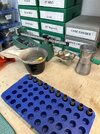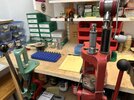For years early on I had a 2x6 that I bolted a Lee single stage to. It was totally portable and a c clamp or f clamp was all I needed to hold it to any coffee table, picnic table, or shooting bench at the range. I’d take it with me to process brass at the park while the kids played, to the range to do final workups, and a friends house to teach them the process. You will always have need for a single stage, even if you move up to a turret or progressive later on.
Another point, a logbook is a must, you just won’t remember the details, especially when you are making different loads. You may have a load for paper, bunnies, 100 yard plinking, deer, or self defense, you may use 3 different powders and 5 different bullets and all have different powder charges and overall lengths. Unless you have a photographic memory the logbook will keep you sane. Then more calibers, more bullet types and weights, more powders, and OAL to keep straight even between same caliber guns that prefer different loads.
I load for 6 different 9mm pistols, I use 2 powders, and 3 bullets, and make 9 loads. Most are just nice target loads tuned to each gun, a couple are self defense loads that work in what I’d grab if the excrement hit the oscillating device. Same with my 223/556 rifles, I have 3 rifles and 5 loads(so far).
My logbook is just a 3 ring binder with photocopies of a log sheet I had 35 years ago. Each caliber is separated by a page of heavy cardstock with a tab indicating caliber. Each load I make is given a number and after the load specifics is a place to note how it shot and any comments. The more info you include, the better. You can refer back later and not waste components on something you already tried that didn’t work.



